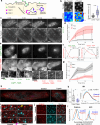Mechano-regulation by clathrin pit-formation and passive cholesterol-dependent tubules during de-adhesion
- PMID: 38217571
- PMCID: PMC10787898
- DOI: 10.1007/s00018-023-05072-4
Mechano-regulation by clathrin pit-formation and passive cholesterol-dependent tubules during de-adhesion
Abstract
Adherent cells ensure membrane homeostasis during de-adhesion by various mechanisms, including endocytosis. Although mechano-chemical feedbacks involved in this process have been studied, the step-by-step build-up and resolution of the mechanical changes by endocytosis are poorly understood. To investigate this, we studied the de-adhesion of HeLa cells using a combination of interference reflection microscopy, optical trapping and fluorescence experiments. We found that de-adhesion enhanced membrane height fluctuations of the basal membrane in the presence of an intact cortex. A reduction in the tether force was also noted at the apical side. However, membrane fluctuations reveal phases of an initial drop in effective tension followed by saturation. The area fractions of early (Rab5-labelled) and recycling (Rab4-labelled) endosomes, as well as transferrin-labelled pits close to the basal plasma membrane, also transiently increased. On blocking dynamin-dependent scission of endocytic pits, the regulation of fluctuations was not blocked, but knocking down AP2-dependent pit formation stopped the tension recovery. Interestingly, the regulation could not be suppressed by ATP or cholesterol depletion individually but was arrested by depleting both. The data strongly supports Clathrin and AP2-dependent pit-formation to be central to the reduction in fluctuations confirmed by super-resolution microscopy. Furthermore, we propose that cholesterol-dependent pits spontaneously regulate tension under ATP-depleted conditions.
Keywords: Excess area regulation; Membrane homeostasis; Tension propagation.
© 2024. The Author(s).
Conflict of interest statement
The authors declare that they have no known competing financial interests or personal relationships that could have appeared to influence the work reported in this paper.
Figures








Similar articles
-
De novo endocytic clathrin coats develop curvature at early stages of their formation.Dev Cell. 2021 Nov 22;56(22):3146-3159.e5. doi: 10.1016/j.devcel.2021.10.019. Epub 2021 Nov 12. Dev Cell. 2021. PMID: 34774130 Free PMC article.
-
Clathrin exchange during clathrin-mediated endocytosis.J Cell Biol. 2001 Oct 15;155(2):291-300. doi: 10.1083/jcb.200104085. Epub 2001 Oct 15. J Cell Biol. 2001. PMID: 11604424 Free PMC article.
-
Exogenous lysophospholipids with large head groups perturb clathrin-mediated endocytosis.Traffic. 2017 Mar;18(3):176-191. doi: 10.1111/tra.12468. Epub 2017 Jan 30. Traffic. 2017. PMID: 28067430
-
Assembly of clathrin-coated pits onto purified plasma membranes.Science. 1987 May 1;236(4801):558-63. doi: 10.1126/science.2883727. Science. 1987. PMID: 2883727 Review.
-
Clathrin coated pits, plaques and adhesion.J Struct Biol. 2016 Oct;196(1):48-56. doi: 10.1016/j.jsb.2016.07.009. Epub 2016 Jul 16. J Struct Biol. 2016. PMID: 27431447 Review.
Cited by
-
The Plasma Membrane and Mechanoregulation in Cells.ACS Omega. 2024 May 13;9(20):21780-21797. doi: 10.1021/acsomega.4c01962. eCollection 2024 May 21. ACS Omega. 2024. PMID: 38799362 Free PMC article. Review.
References
-
- Anderson RH, Sochacki KA, Vuppula H, Scott BL, Bailey EM, Schultz MM, Kerkvliet JG, Taraska JW, Hoppe AD, Francis KR. Sterols lower energetic barriers of membrane bending and fission necessary for efficient clathrin-mediated endocytosis. Cell Rep. 2021 doi: 10.1016/J.CELREP.2021.110008. - DOI - PMC - PubMed
MeSH terms
Substances
Grants and funding
LinkOut - more resources
Full Text Sources
Research Materials

